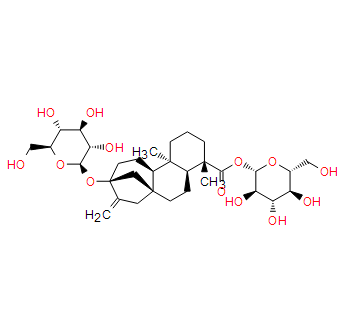| Cas No.: | 64849-39-4 |
| SMILES: | O=C([C@@]1(C)[C@]2([H])[C@](CCC1)(C)[C@@](CC3)([H])[C@@](C[C@@]3(C4=C)O[C@H](O[C@H](CO)[C@H]5O)[C@H](O)[C@H]5O)(C4)CC2)O[C@H](O[C@@H]6CO)[C@H](O)[C@@H](O)[C@@H]6O |
| Formula: | C32H50O13 |
| M.Wt: | 642.73 |
| Purity: | >98%, Standard References Grade |
| Sotrage: | 4°C for 1 year, -20°C for more than 2 years |
| Description: | Rubusoside is a natural sweetener and a solubilizing agent with antiangiogenic and antiallergic properties. Rubusoside is an excellent solubilizing agent. It can enhance the solubility of a number of pharmaceutically important compounds, such as liquiritin, teniposide, curcumin, and etoposide. |
| References: | [1]. Wang Z et al. Selective production of rubusoside from stevioside by using the sophorose activity of β-glucosidase from Streptomyces sp. GXT6. Appl Microbiol Biotechnol. 2015 Nov;99(22):9663-74. [2]. Ko JA et al. Mass production of rubusoside using a novel stevioside-specific β-glucosidase from Aspergillus aculeatus. J Agric Food Chem. 2012 Jun 20;60(24):6210-6. |

 DC Chemicals' products qualify for U.S. tariff exemptions. We guarantee no price increases due to customs duties and maintain stable supply, continuing to deliver reliable research solutions to our American clients.
DC Chemicals' products qualify for U.S. tariff exemptions. We guarantee no price increases due to customs duties and maintain stable supply, continuing to deliver reliable research solutions to our American clients.





















